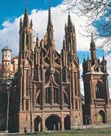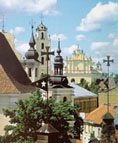Lithuania is an enigma, especially for tourists. Many cannot decide whether the country and its capital, Vilnius, are gems waiting to be discovered by hordes of camera-toting tourists from Asia or unripe fruits dreading the influx of backpackers and unsympathetic foreigners. In many ways, the country's tourism sector reflects this ambivalence.
For travellers, this ambivalence remains a double-edged sword. Less tourists means that prices in Vilnius are much lower than in Riga or Tallinn. However, the creature comforts demanded by many travellers are scarcer in Vilnius than in its northern counterparts. This incites a love-hate relationship with Vilnius; at times, it is absolutely the best, most beautiful of the three capitals, and at other times, it feels absolutely backward and uncomfortable. Efforts to promote tourism seem to be rather halfway as well, with the city's real prizes remaining hidden for the many possible tourists. For example, do people know that the top hotel in the city, the SAS Radisson Astorija, has probably the lowest room rates during weekends, going as low as about USD 50 a night?
Nevertheless, those who have discovered Vilnius and have fallen in love with it are not alone. Vilnius has the flavour of central, Catholic Europe, with some of the most fantastic churches around. Whether it is the crown on top of St Casimir's Church, the painting of the Madonna in the Gates of Dawn or the red-brick design of St Anne's Church,
 |
| St Anne's Church |
Despite Vilnius being arguably the most picturesque capital among the three Baltic countries' major cities, it has not been duly rewarded with a large influx of tourists. A combination of many factors, such as geography, transportation, history and infrastructure, helps explain the relative drought of tourists, compared to Riga or Tallinn. Being an inland capital, unlike the others, Vilnius does not have the advantage of a port to bring in travellers by sea. For tourists looking to approach the Baltics by sea, Riga and Tallinn stand out as a bit more attractive than Lithuania's port town Klaip─-da.
Rail travel to Lithuania is limited, and getting to and from Vilnius from the heart of Central Europe is considerably more difficult and indirect than one would expect. Bus travel is uncomfortable for many tourists, and the rail and bus stations are less than adequate - even compared to their Latvian and Estonian counterparts, which are already not quite up to par. Air travel suffered a minor jolt when British Airways cancelled their Heathrow-Vilnius route (on economic grounds, they argue, although rumour has it that the plethora of Lithuanian asylum seekers contributed to the decision), but it is still the best way to get to Vilnius. Car travel, especially from Poland, is not advised, unless one's idea of a holiday is sitting in a car queuing at the border, watching impatient lorry drivers curse.
Then there is the infrastructure problem. Without the massive ex-pat or alcohol tourism impact experienced by Tallinn and Riga, some of the basic comforts familiar to travellers are lacking in Vilnius. Most importantly: cash machines. Unlike tourist centres around the world, from Riga to Taipei, there is a real lack of places to get money - especially on weekends, when some cash machines seem to be shut down. Taxis are also less than trustworthy in general. Some hotel restaurants still feature the infamous post-Communist menus, with plenty of blank spots instead of prices. Then there is the most infamous symbol of Vilnius's problems with tourism: the Lietuva hotel.
Forgive the personal diversion, but Lietuva is among the worst of the Intourist hotels I have ever had the misfortune of staying in, when I made my first visit to Vilnius in 1994. I had fallen in love with the city and for many years it was my favourite of the Baltic cities, except for that hulking mess across the river. I will spare further description, as the hotel's new Norwegian parent company has plans to renovate; I recommend dynamite. Lietuva is also the biggest hotel in the capital, and the inability to transform it into a viable entity after so many years is endemic to the sector's problems.
Tourism authorities need to make use of Vilnius's advantages - and it has many. Not many places in the world can offer an excellent meal of exotic game in a mediaeval cellar for a few dollars. Vilnius is a shopper's bargain, a drinker's haven, a photographer's fantasy, a dieter's nightmare. Authorities must also do something about Vilnius's problems. For example, next to beautiful churches and viewing areas, there ought not to be overflowing skips reeking of last month's sour cream and cabbage.
Lithuania also has much to offer outside of Vilnius, and many of these locales are frequented often due to their convenient geographic postions. Tourism officials smartly promote quick trips out from Vilnius to Trakai,
 |
| A grand duke's island getaway |
Being the former provisional capital and a main transport hub, Kaunas gets its fair share of tourists as well. Residents would argue that the city is "more Lithuanian" than Vilnius. Of all the Baltic countries, only Lithuania has a strong tourism market in its second city. Excellent sites, fascinating museums, relaxing cafes, and what's more, Kaunas is worth a trip even without a planned train change.
Klaip─-da, the main port of the country, acts as the transit to the dreamy Couronian Spit: miles and miles of sand dunes and small tranquil villages, which inspired many creative minds over the centuries, including writer Thomas Mann.
 |
| Aukštaitija National Park |
The amount of tourism potential in Lithuania is limitless, once people in the country recognise it, that is. They also need to recognise that the tourist industry is high in intensity and competition and requires constant learning and adaptation. National pride needs to be tempered by learning from others having experienced similar developmental situations. With a few minor changes, Lithuania will easily become the best bargain for good travel throughout Central Europe. Foundations, after all, are more important than any flashy gimmick. As the saying goes, "if you build it, they will come."
Mel Huang, 6 April 2000
Photos courtesy of: the Lithuanian Department of Tourism and the City of Vilnius.
Lithuania Links:
Baltic Profiles:
Moving on:



